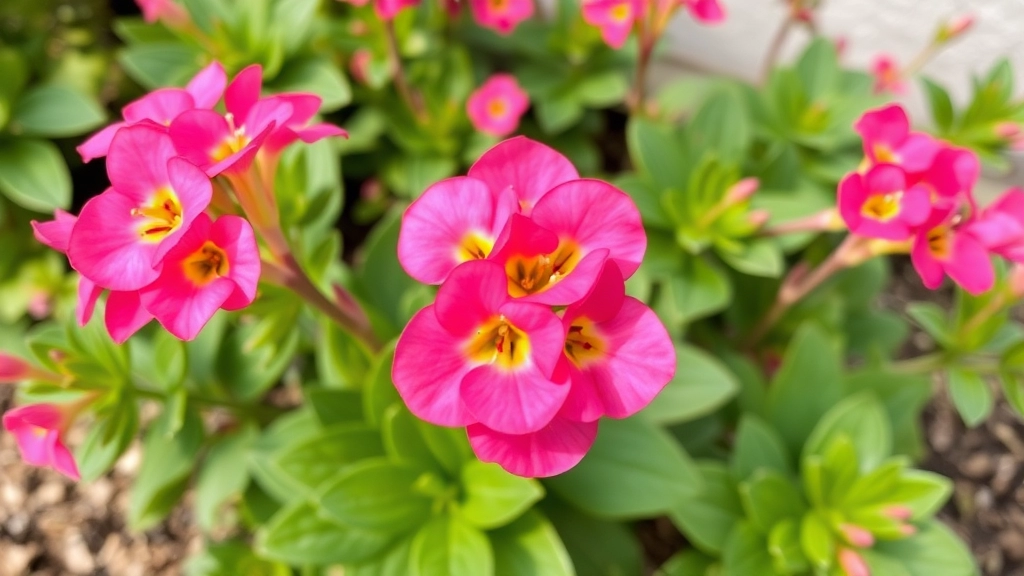Curious about the Kalanchoe Bloom Season?
You’re not alone. These vibrant, low-maintenance plants are a favourite for their long-lasting flowers, but knowing when they naturally bloom can help you enjoy them even more. Typically, Kalanchoe plants bloom in late winter to early spring, brightening up those dull months with their colourful display.
Keeping Your Kalanchoe Blooming Year-Round
To keep your Kalanchoe blooming year-round, it’s essential to mimic their natural conditions. Adequate light, proper temperature, and a bit of dormancy can do wonders. By adjusting these factors, you can encourage your Kalanchoe to rebloom and maintain their stunning appearance indoors.
Dive into the Specifics
Let’s dive into the specifics to help you master the art of Kalanchoe care.
Natural Blooming Period of Kalanchoe
Are you struggling to get your Kalanchoe to bloom? Understanding its natural blooming period is crucial for fostering those vibrant flowers.
Kalanchoe, a popular succulent, typically blooms in late winter to early spring.
During this period, you can expect an impressive display of clusters of tiny, colourful flowers.
Key Points about Kalanchoe’s Natural Blooming Period:
- Seasonal Timing: The blooming season generally begins around January and can last until April.
- Light Influence: The blooming is closely related to the amount of light the plant receives each day.
- Age Matters: Younger plants might not bloom as profusely as mature ones.
For more detailed tips on how to care for your blooming Kalanchoe, check out our ultimate guide to flowering Kalanchoe care. Additionally, if you’re interested in the various species of this beautiful plant, explore our guide to different Kalanchoe species for your garden.
Key Factors for Promoting Kalanchoe Blooms
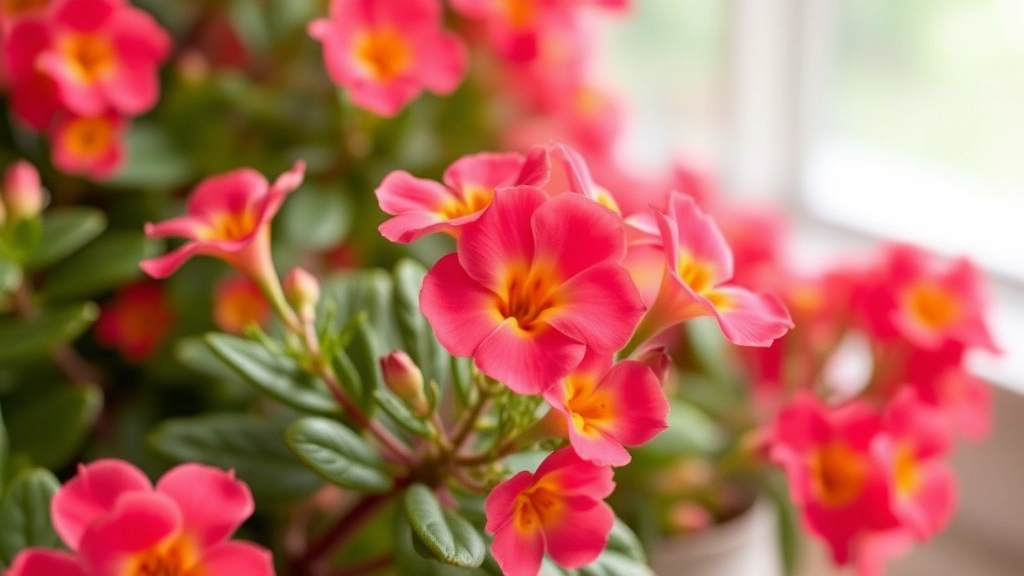
So, you’re keen on getting your Kalanchoe to bloom beautifully, right? It’s a common worry for many plant lovers. But don’t fret! There are some straightforward factors you can focus on to encourage those vibrant flowers.
1. Proper Lighting
- Location: Place it near a south-facing window.
- Duration: Aim for around 6 hours of bright, indirect sunlight daily.
- Warning: Too much direct sunlight can scorch the leaves.
2. Temperature Control
- Ideal Range: Keep temperatures between 18°C to 24°C.
- Avoid Cold: Protect them from drafts and sudden temperature drops.
3. Watering Wisely
- Check the Soil: Make sure the top inch is dry before you water again.
- Drainage: Use pots with drainage holes to prevent soggy roots.
4. Soil Quality
- Type: Use well-draining potting soil.
- Additions: Consider adding perlite or sand for extra drainage.
5. Fertilizer Application
- Type: Use a balanced, water-soluble fertilizer.
- Schedule: Fertilize every 2-4 weeks during the growing season.
6. Pruning and Deadheading
- Remove Dead Blooms: Snip off spent flowers to encourage new growth.
- Shape It Up: Prune for a bushier appearance, which can lead to more blooms.
When it comes to ensuring your Kalanchoe blooms beautifully, one of the first questions that often arises is about its light and temperature needs.
Kalanchoe plants thrive in specific environmental conditions that can significantly impact their blooming potential. To achieve optimal growth and vibrant flowers, consider the following essential factors:
### Light Requirements
– **Bright, Indirect Light**: Kalanchoe prefers bright, indirect sunlight. A south-facing window is ideal, but avoid direct sunlight, which can scorch the leaves.
– **Duration**: Aim for about 12 to 14 hours of light daily during the blooming period.
– **Supplemental Lighting**: If natural light is limited, consider using grow lights to provide the necessary illumination.
### Temperature Preferences
– **Ideal Range**: Kalanchoe thrives in temperatures between 18°C to 24°C (65°F to 75°F).
– **Avoid Extremes**: Protect your plant from sudden temperature changes and avoid placing it near drafts or heating vents.
– **Night Temperature**: A slight drop in temperature at night can help stimulate blooming, but ensure it doesn’t drop below 10°C (50°F).
By providing the right light and temperature conditions, you can set the stage for a stunning bloom display. For more detailed care tips, check out the [ultimate guide to flowering Kalanchoe care](https://planthq.org/ultimate-guide-to-flowering-kalanchoe-care-tips-for-blooming/) and learn about the [causes and solutions for Kalanchoe leaves curling](https://planthq.org/causes-and-solutions-for-kalanchoe-leaves-curling/).
The Role of Dormancy in Reblooming
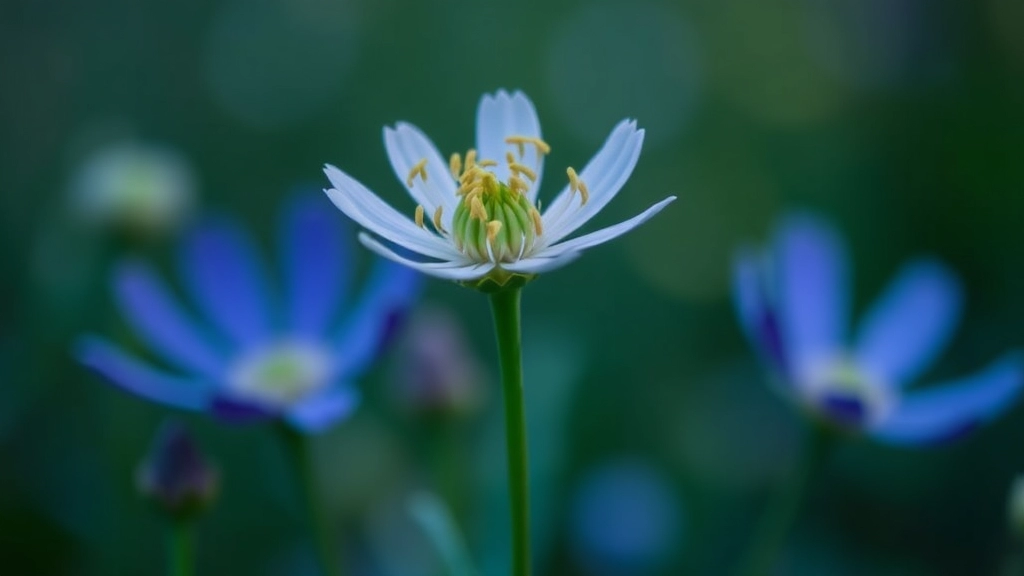
Many plant enthusiasts often wonder why their Kalanchoe isn’t blooming as expected.
Understanding the role of dormancy is crucial for encouraging reblooming in these vibrant succulents.
What is Dormancy?
Dormancy is a natural period of rest for Kalanchoe, typically occurring after the blooming phase. During this time, the plant conserves energy and prepares for the next growth cycle.
Why is Dormancy Important?
- Energy Conservation: The plant needs this period to gather strength for future blooms.
- Nutrient Redistribution: Nutrients are redirected from spent flowers to new growth.
- Stress Management: Dormancy helps the plant recover from environmental stresses.
How to Manage Dormancy for Reblooming
- Reduce Watering: Cut back on watering during the dormancy phase. This encourages the plant to rest and prevents root rot.
- Lower Fertilization: Avoid fertilising while the plant is dormant. This allows it to focus on recovery rather than new growth.
- Maintain Ideal Conditions: Keep the plant in a cool, dry place with indirect light.
Signs Your Kalanchoe is Ready to Rebloom
- New Growth: Look for new leaves or stems emerging.
- Increased Light Needs: As the plant wakes up, it will require more light to support blooming.
Watering and Soil Care for Healthy Blooming
When it comes to ensuring your Kalanchoe thrives and produces stunning blooms, proper watering and soil care are paramount. Many plant enthusiasts often find themselves puzzled about how much water their Kalanchoe needs and what type of soil is best. Let’s break it down.
Watering Guidelines
- Frequency: Water your Kalanchoe when the top inch of soil feels dry. This typically translates to every 2-3 weeks, but it can vary based on your home environment.
- Method: Use the “soak and dry” method. Water thoroughly until it drains from the bottom, then allow the soil to dry out before the next watering. This prevents root rot, a common concern for Kalanchoe.
- Signs of Overwatering: Yellowing leaves or a mushy stem are telltale signs that you’re giving your plant too much water.
Soil Selection
Choosing the right soil is just as crucial as watering. Kalanchoe prefers well-draining soil, which mimics its natural habitat.
- Potting Mix: Opt for a cactus or succulent mix that contains perlite or sand. This will facilitate drainage and prevent water retention.
- pH Level: A slightly acidic to neutral pH (around 6.0-7.0) is ideal for Kalanchoe. You can test your soil with a simple pH kit.
Tips for Soil Care
- Repotting: Consider repotting every couple of years to refresh the soil and provide more space for growth.
- Drainage: Ensure your pot has drainage holes. This helps excess water escape, reducing the risk of root rot.
By maintaining a careful balance of watering and selecting the right soil, you can create an environment where your Kalanchoe can flourish and bloom beautifully. For more detailed guidance, check out our Kalanchoe Paddle Plant Care Guide and learn about the best tips and techniques for pruning Kalanchoe plants.
Fertilizing Tips to Encourage Blooming
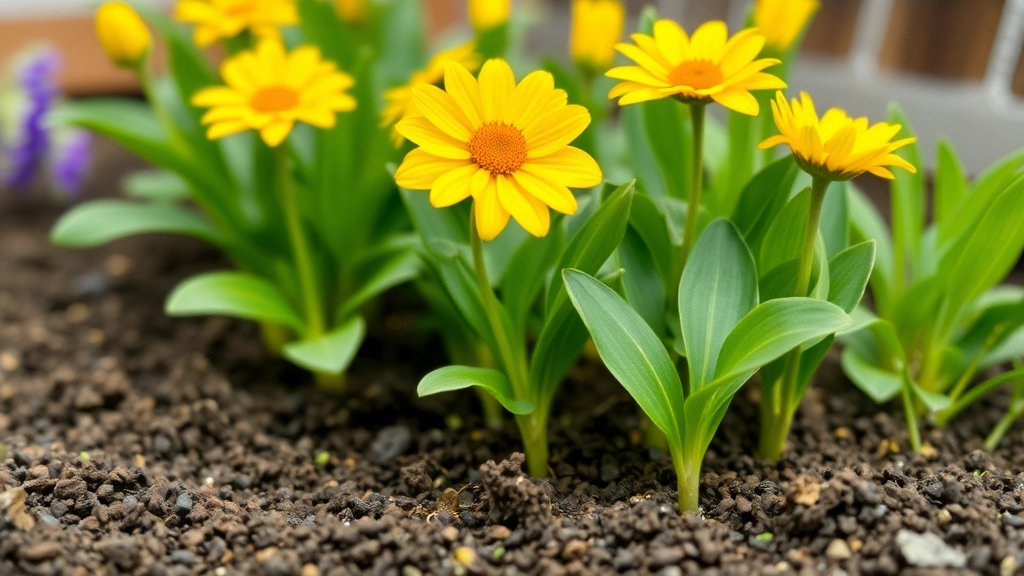
So, you’ve got your Kalanchoe looking lush and green, but where are those blooms? It might just be time to give it a little extra love with some fertiliser.
Why Fertilising Matters
Fertilising is like giving your plant a good meal. It helps provide essential nutrients that promote blooming.
Here are some easy tips to get you started:
- Choose the Right Fertiliser: Look for a balanced, water-soluble fertiliser. Something like a 15-30-15 mix works wonders for Kalanchoe. The higher phosphorus content encourages those beautiful blooms.
- Frequency is Key: Fertilise every 4-6 weeks during the growing season. You want to keep that nutrient flow steady, but don’t overdo it.
- Dilution Matters: Always dilute your fertiliser to half the recommended strength. Too much can burn those lovely roots.
- Timing is Everything: Apply fertiliser when your Kalanchoe is actively growing, usually in spring and summer. Avoid fertilising during dormancy in the fall and winter.
- Observe and Adjust: Keep an eye on your plant. If it’s not blooming, you might need to tweak your fertilisation routine.
Think of fertilising as a way to boost your Kalanchoe’s confidence. Just like we feel better with a good meal, your plant will respond with vibrant blooms!
Pruning Techniques for Prolonging Bloom Period
As we delve into the art of keeping your Kalanchoe blooming longer, it’s essential to consider how pruning plays a pivotal role in this process.
Pruning isn’t just about aesthetics; it’s about encouraging new growth and ensuring your plant remains vibrant. Many plant enthusiasts worry about when and how to prune their Kalanchoe to maximise its blooming potential. Here’s how to approach it:
- Timing is Key:
- Prune your Kalanchoe after the blooming period has ended.
- This timing allows the plant to focus its energy on new growth.
- Cutting Techniques:
- Use clean, sharp scissors or pruning shears to avoid damaging the plant.
- Trim back spent blooms and any dead or yellowing leaves.
- Aim to cut just above a leaf node to encourage new growth.
- Shape and Size:
- Maintain a balanced shape by trimming back overly long stems.
- This not only improves the plant’s appearance but also promotes airflow, reducing the risk of disease.
- Frequency:
- Regularly check your Kalanchoe and prune as needed throughout the growing season.
- A light trim every few weeks can encourage continuous blooming.
Pruning can seem daunting, but it’s a rewarding process that leads to healthier plants and more blooms. For more detailed guidance, you can refer to our essential Kalanchoe care tips for summer success and learn about how to care for scalloped Kalanchoe succulents.
Common Problems Preventing Kalanchoe Blooming
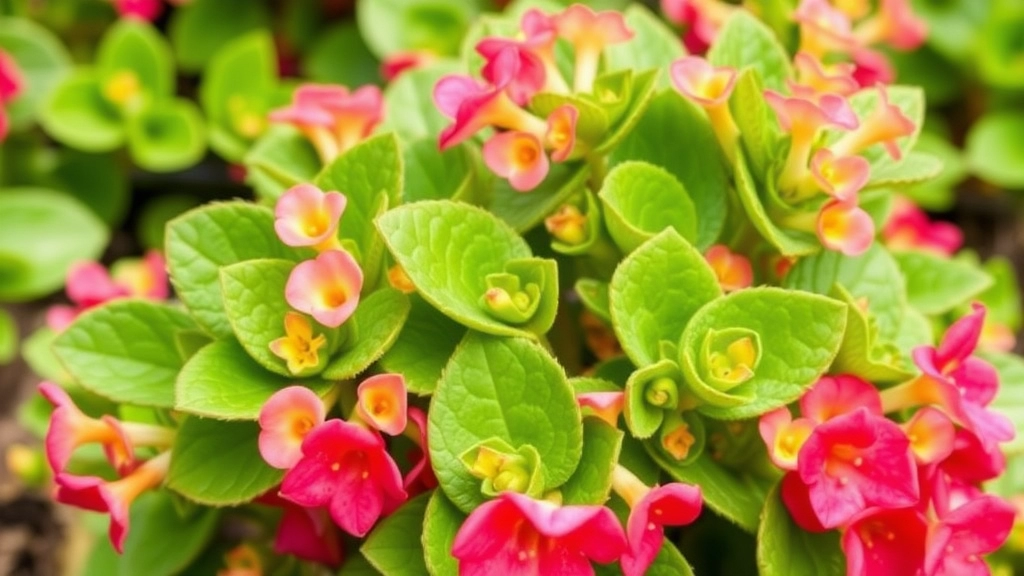
Ever wondered why your Kalanchoe isn’t blooming like it should? You’re not alone. Many plant lovers face this dilemma, and it can be pretty frustrating. Let’s dive into some common issues that might be holding back those beautiful blooms.
1. Insufficient Light
Kalanchoe loves the sun! If it’s not getting enough light, it simply won’t bloom.
- Solution: Place it in a bright spot, ideally near a south-facing window. Aim for at least 6 hours of indirect sunlight daily.
2. Overwatering
Too much water can drown your plant and lead to root rot.
- Signs: Yellowing leaves or a mushy stem are telltale signs.
- Solution: Allow the soil to dry out between waterings. Stick your finger in the soil—if it feels dry an inch down, it’s time to water.
3. Poor Soil Quality
Kalanchoe thrives in well-draining soil. If the soil is too heavy or compact, it can hinder blooming.
- Solution: Use a cactus or succulent mix for optimal drainage.
4. Lack of Nutrients
If your Kalanchoe isn’t getting enough nutrients, it may struggle to produce flowers.
- Solution: Fertilize with a balanced, water-soluble fertiliser every couple of weeks during the growing season.
5. Temperature Fluctuations
Extreme temperature changes can stress your plant, leading to fewer blooms.
- Ideal Range: Keep it between 18-24°C (65-75°F). Avoid placing it near drafts or heating vents.
6. Not Enough Dormancy
Believe it or not, Kalanchoe needs a rest period to bloom again. If you keep it in bloom mode all year round, it might just give up.
- Solution: Allow it to go dormant for a few weeks by reducing light and water in the winter.
7. Pests and Diseases
Sometimes, unseen pests like aphids or mealybugs can sap the energy from your plant.
- Solution: Regularly check for pests. If you spot any, treat them with insecticidal soap or neem oil.
Extending the Bloom Cycle Indoors
Are you struggling to keep your Kalanchoe blooming indoors? It can be frustrating when you’ve nurtured your plant, yet it seems to lose its vibrant flowers too soon. Fortunately, there are several strategies to extend the bloom cycle of your Kalanchoe, ensuring you enjoy its beauty for longer.
FAQs about Kalanchoe Bloom Season
What is the best location for my Kalanchoe to bloom?
Place your Kalanchoe near a south-facing window to ensure it gets around 6 hours of bright, indirect sunlight daily. Too much direct sunlight can scorch the leaves.
What temperature range is ideal for Kalanchoe?
Keep temperatures between 18°C to 24°C (65-75°F). Avoid drafts and sudden temperature drops to maintain optimal conditions.
How often should I water my Kalanchoe?
Water your Kalanchoe when the top inch of soil is dry. Ensure the pot has drainage holes to prevent soggy roots, which can lead to root rot.
What type of soil is best for Kalanchoe?
Use well-draining potting soil. Adding perlite or sand can improve drainage, which is crucial for the health of your Kalanchoe.
How often should I fertilize my Kalanchoe?
Fertilize every 2-4 weeks during the growing season with a balanced, water-soluble fertilizer. Dilute it to half the recommended strength to avoid burning the roots.
Why is my Kalanchoe not blooming?
Several factors can prevent blooming, including insufficient light, overwatering, poor soil quality, lack of nutrients, temperature fluctuations, lack of dormancy, and pests or diseases. Addressing these issues can help encourage blooms.
What is dormancy, and why is it important for Kalanchoe?
Dormancy is a natural rest period for Kalanchoe, usually after the blooming phase. It conserves energy, redistributes nutrients, and helps the plant recover from environmental stresses, preparing it for the next growth cycle.
How do I manage dormancy to encourage reblooming?
Reduce watering and avoid fertilizing during dormancy. Maintain ideal conditions by keeping the plant in a cool, dry place with indirect light. Look for signs of new growth to know when the plant is ready to rebloom.
What are common problems preventing Kalanchoe from blooming?
Common issues include insufficient light, overwatering, poor soil quality, lack of nutrients, temperature fluctuations, inadequate dormancy, and pests or diseases. Addressing these problems can help your Kalanchoe bloom beautifully.
How can I encourage my Kalanchoe to bloom more frequently?
Ensure proper lighting, temperature control, watering, soil quality, and fertilization. Prune and deadhead spent flowers to promote new growth. Managing dormancy periods also helps in encouraging frequent blooming.
How can I identify if my Kalanchoe is ready to rebloom?
Look for signs of new growth such as new leaves or stems. The plant will also require more light as it wakes up from dormancy. These signs indicate that your Kalanchoe is ready to start blooming again.
References
-
Tips for Getting Your Kalanchoe to Bloom
-
How to Grow Kalanchoe Plants
-
Kalanchoe: How to Grow and Care for Kalanchoe Plants
